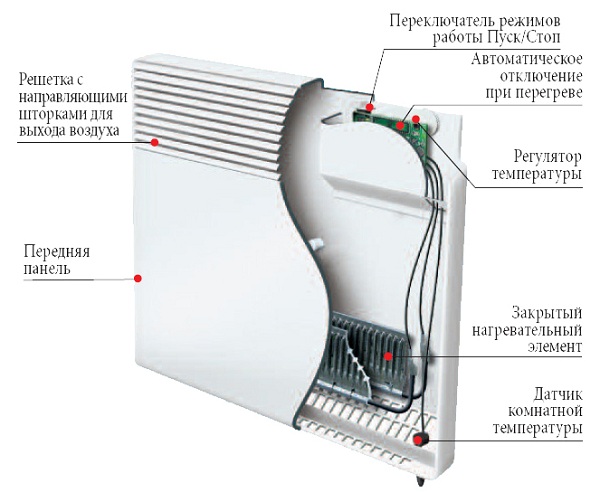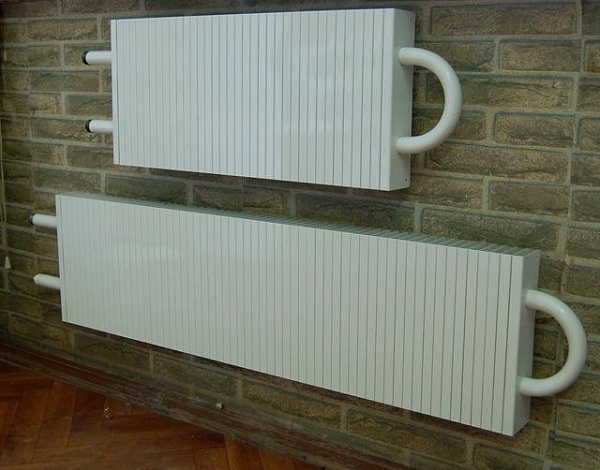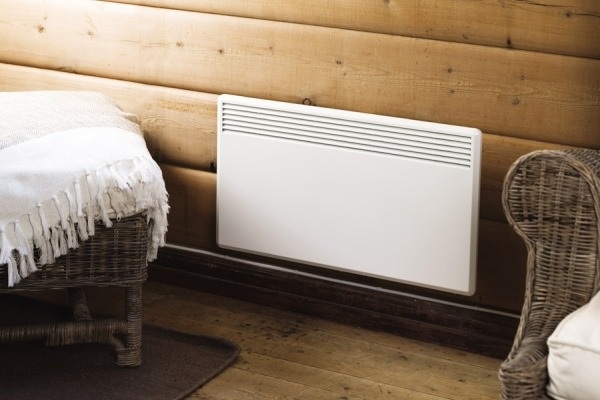Types of convectors for space heating
A familiar situation: the heating season has not yet begun (or has already ended), but the weather on the street does not know about it. The apartments are cold and damp. During this period, it is worth worrying about additional sources of heating. Excellent proven convector batteries. On the modern market, types of convectors are presented in a very large assortment - that is why this review is useful in helping to select the right model.
Content
Principle of operation of convectors
In order not to freeze without heating, it is enough to purchase an appropriate radiator. In our case, the device acts according to the observance of the laws of physics - cold air goes through the bottom, while hot rushes up. Thanks to this the movement of air masses the room and starts to warm up.

Models of various convectors are similar to each other - all of them are united by a similar device:
- The direct heating element is located below.
- At the heat exchanger flat ribs - so the heating efficiency increases.
- The whole structure is hidden in a special casing, which has openings for warm and cold air.
- Some devices have a special screen that adjusts the flow.
One of the interesting features of the device is that in the process of work the cover will not get very hot. However, it all depends on the technology itself.
Types of devices
Types of convectors classified according to the energy source consumed. They are:
By the nature of the installation device can be floor standing, wall mounted and recessed into the window sill or gender (vnutripolnye and baseboards). If everything is clear with the first two, then it is worth thinking about the placement of the last type (embedded) at the design stage of the room.
There are on sale models supplied forced air circulation. In fact, in such units are powerful fans. In addition to the active distillation of air streams, they are good in that they cool the heating element itself. The fan does not consume too much power, so you can safely choose a similar option.

Gas convector
A heating device of this type inside the heat exchanger has a gas burner. When the fuel is burned, heat energy begins to be released - it rises through the apparatus and heats the incoming air.
In this design there is one critical drawback - the products of combustion must go somewhere. For this device is provided chimney. Because of these features, the unit will not be moved to different rooms, but there is good news: the gas convector can be used as the main source of heat (not least because of the productive power of 2-6 kW).

Electroconvectors
Electrical devices are widely recognized for their ease of operation - the device is simply plugged in.
By type of heating element electroconvectors are divided into the following types:
- with an open spiral;
- with a closed spiral;
- monoblock.
The first, of course, the most budget, but their disadvantage lies precisely in open work: from the air will burn oxygen, when dust gets on the spiral, an unpleasant smell emanates, and the heating will not go above 150 degrees. In the second case, there is also a danger of overheating of the heater. The safest thing to choose monoblock devices: they are more reliable and last for a long time.

There is one “but”: a similar device is good only as an additional heating device in the room. This is due to the low power of work - only 2 kW.
Water convector
How does a water heater? As a source of energy is used here heat transfer fluid (water, antifreeze or oil). In appearance, the unit is represented by a metal pipe on which the ribs are welded (just the liquid runs through them). All of this design is somewhat similar to the usual central heating batteries. Most often they are steel or bimetallic (copper and aluminum) products.

This clauseThe device for heating is good because its walls themselves do not heat up much in the process of work. The room will be heated only by convection itself, and not by hot equipment.
Infrared convection heater
Heating by the convection principle can occur due to infrared radiation. Bioconvector promises rapid heating of the room, and its service life is 30 years. He is handsome in appearance: in some models, the panel is made of artificial stone, there is a fan, a thermostat and other "chips". What can such a unit?

The distinctive feature of the device is that it warms the room with infrared radiation. This creates a special atmosphere - the indoor air is not dried. Such electric heaters are very mobile and convenient.
The device heats well, but only if it is a closed room - that is, a closed space.
Advantages and disadvantages
The convector is a reliable and powerful device that rightfully has earned a reputation as a reliable and safe assistant. The undoubted advantages are:
- minimum thickness;
- easy installation (on almost any wall);
- quiet operation;
- Availability thermostat to maintain the ideal temperature in the room;
- economy in use (when reaching the specified thermal values, they switch to minimum power);
- safety (gas units stop functioning if the fire goes out).
There are some disadvantages:
- In models that are not equipped with a fan, heating will be much slower.
- Moving air flows will move the dust in the room too (therefore it is worth more often to carry out wet cleaning).
- The temperature in the room at different heights is different - the ceiling can occur heat cushion.
- There is a possibility of drafts - this is due to the movement of air masses.
- Dust collects inside the device (it is necessary to clean it 1-2 times a year).
In summary, we can confidently recommend such a device for purchase in a regular average apartment or a country house. It will cope with the creation of a comfortable atmosphere, and electric types can even replace a broken stationary radiator.

/rating_off.png)












